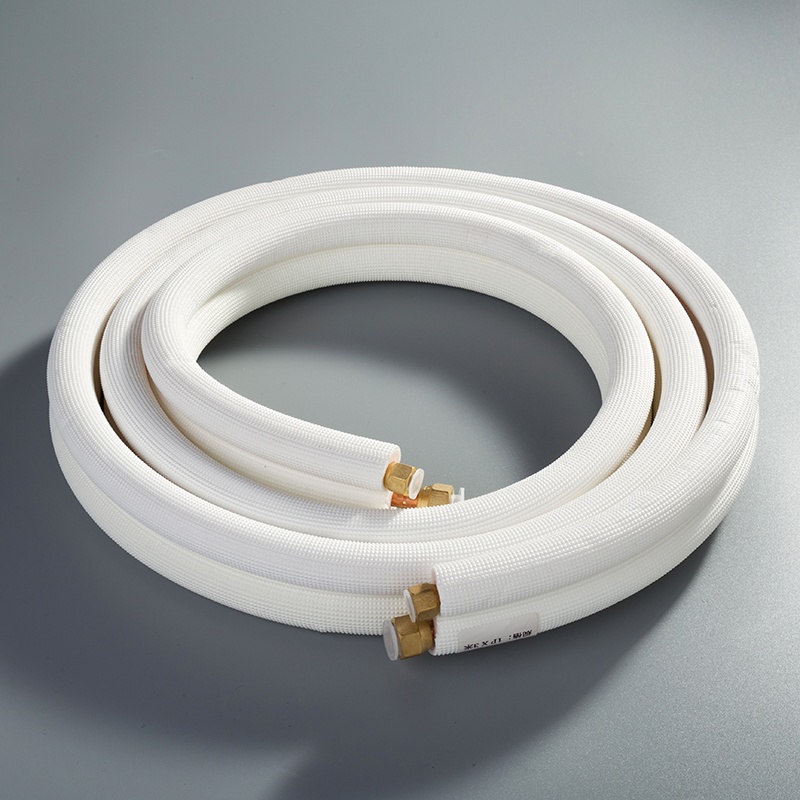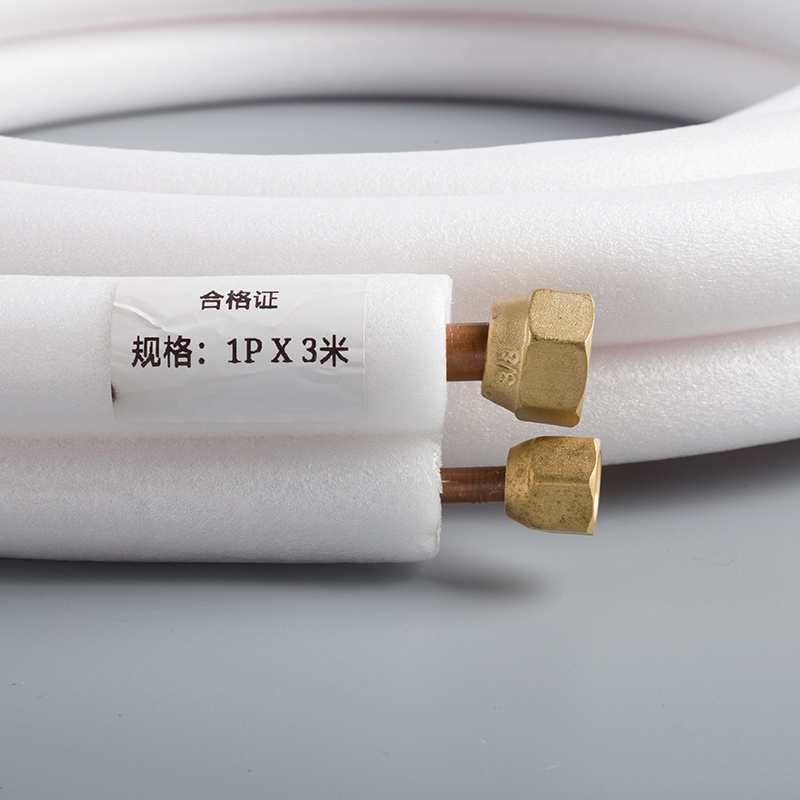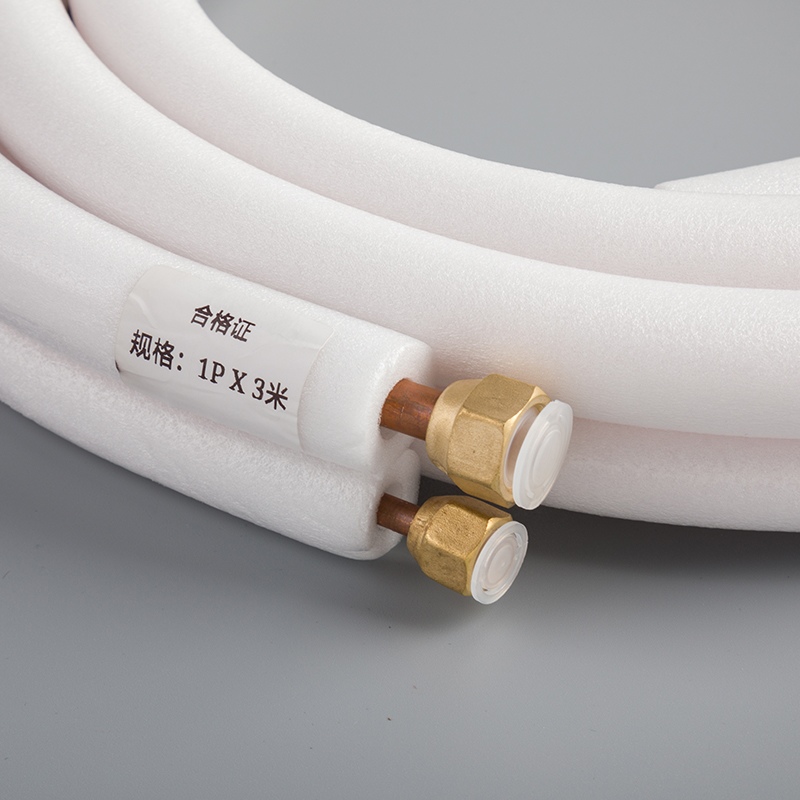Split HVAC Copper Line Set Installation Guide

Proper installation of copper line sets is crucial for the efficiency and longevity of your HVAC system. Copper pipes are a popular choice due to their durability and reliability. When you install split HVAC copper line set pipes tube for air conditioners copper air conditioner copper pipe correctly, you ensure optimal performance and energy efficiency. Regular maintenance and insulation keep these linesets functioning effectively, preventing potential issues and extending the lifespan of your system. By prioritizing proper installation, you contribute to a more reliable and efficient HVAC setup.
Key Takeaways
Proper installation of copper line sets is essential for the efficiency and longevity of your HVAC system, ensuring optimal performance and energy savings.
Gather the right tools, such as a pipe cutter, flaring tool, and torque wrench, to facilitate a smooth installation process and prevent leaks.
Conduct a thorough site inspection to identify obstructions and ensure a clear path for the copper pipes, which is crucial for a successful installation.
Always prioritize safety by wearing personal protective equipment and ensuring proper ventilation while working with refrigerants.
Accurate measurements and clean cuts are vital; double-check your pipe lengths to avoid waste and ensure proper fitting.
Regularly inspect your copper linesets for leaks and insulation integrity to maintain system efficiency and extend the lifespan of your HVAC setup.
If uncertain about any installation steps, consider consulting a professional to ensure the job is done correctly and safely.
Tools and Materials Needed

To successfully install copper linesets, you must gather the right tools and materials. This ensures a smooth installation process and enhances the efficiency of your HVAC system.
Essential Tools for Installing Copper Linesets
Having the correct tools is crucial when working with copper piping systems. Here are the essential tools you will need:
Pipe cutter
A pipe cutter is indispensable for cutting copper pipes to the desired length. It provides clean cuts, which are vital for ensuring proper connections and preventing leaks.
Flaring tool
The Flaring Tool is essential for creating the proper flare at the ends of your copper tubing. This tool helps in forming a secure connection between pipes and fittings, reducing the risk of refrigerant leaks.
Tube bender
A tube bender allows you to bend copper pipes without kinking them. Proper bending ensures that the refrigerant flows smoothly through the system, maintaining optimal performance.
Torque wrench
A torque wrench is necessary for tightening fittings to the correct specifications. This prevents over-tightening, which can damage the fittings, and under-tightening, which can lead to leaks.
Required Materials for Copper Piping Systems
In addition to tools, you need specific materials to complete the installation of copper linesets:
Copper pipes
Copper pipes are the backbone of your HVAC system. They offer excellent thermal conductivity and durability, making them ideal for efficient heat transfer.
Insulation
Insulation is crucial for copper pipes to prevent condensation and improve energy efficiency. Proper insulation helps maintain the temperature of the refrigerant, reducing energy loss.
Fittings and connectors
Fittings and connectors are used to join copper pipes together. They ensure a secure and leak-free connection, which is vital for the system's reliability.
Refrigerant
Refrigerant is the fluid that circulates through the copper piping systems, absorbing and releasing heat. Using the correct type and amount of refrigerant is essential for the system's efficiency and performance.
By gathering these tools and materials, you set the foundation for a successful installation of copper linesets. This preparation not only simplifies the process but also contributes to the long-term reliability of your HVAC system.
Preparation Steps for Properly Installing Copper Linesets
Before you begin the installation of copper linesets, thorough preparation is essential. This ensures that the process goes smoothly and that your HVAC system operates efficiently.
Site Inspection for Split HVAC Copper Line Set Pipes
Assessing the installation area: Start by examining the area where you plan to install the copper linesets. Look for a clear path between the indoor and outdoor units. Ensure that the space allows for easy access and maintenance. Properly install copper linesets by confirming that the area can accommodate the necessary pipe lengths without excessive bending or stretching.
Checking for obstructions: Identify any potential obstacles that might interfere with the installation. These could include structural elements, electrical wiring, or other utilities. Removing or working around these obstructions is crucial to properly install copper linesets. This step prevents future issues and ensures a seamless installation process.
Safety Measures for Copper Air Conditioner Copper Pipe Installation
Personal protective equipment: Safety should always be a priority. Wear appropriate personal protective equipment (PPE) such as gloves, safety glasses, and protective clothing. This gear protects you from sharp edges, refrigerant exposure, and other potential hazards during the installation.
Ensuring proper ventilation: Adequate ventilation is vital when working with refrigerants and other materials. Make sure the workspace is well-ventilated to avoid inhaling harmful fumes. This precaution helps maintain a safe environment and contributes to a successful installation.
Expert Testimony: "Installing a line set is a critical part of setting up your HVAC unit, which is not to be taken lightly. Every stage must be meticulously performed to guarantee that the mechanism functions effectively and endures for years to come." This insight underscores the importance of careful preparation and attention to detail when you properly install copper linesets.
By following these preparation steps, you lay the groundwork for a successful installation. Proper site inspection and adherence to safety measures ensure that you properly install copper linesets, leading to an efficient and reliable HVAC system.
Installation Process of Copper Piping Systems

Installing split HVAC copper line set pipes tube for air conditioners copper air conditioner copper pipe involves several precise steps. Each step ensures that your HVAC system operates efficiently and reliably. Let's explore the process in detail.
Cutting and Bending Copper Pipes for Air Conditioners
Measuring and marking: Begin by accurately measuring the distance between the indoor and outdoor units. Use a tape measure to determine the length of copper pipes needed. Mark the pipes with a marker or pencil to indicate where you will cut. Accurate measurements prevent unnecessary waste and ensure a smooth installation process.
Using a pipe cutter: With your measurements marked, use a pipe cutter to cut the copper pipes. Position the cutter on the mark and rotate it around the pipe, applying gentle pressure. This tool provides clean cuts, which are essential for secure connections. Clean cuts also help prevent leaks in your HVAC system.
Bending techniques: After cutting, you may need to bend the copper pipes to fit the installation path. Use a tube bender to achieve smooth bends without kinking the pipes. Proper bending ensures that refrigerant flows efficiently through the linesets, maintaining optimal performance.
Connecting Copper Pipes in HVAC Systems
Flaring the pipe ends: Once you have cut and bent the pipes, flare the ends using a flaring tool. This step is crucial for creating a secure connection between the pipes and fittings. Proper flaring reduces the risk of refrigerant leaks, which can compromise the efficiency of your HVAC system.
Securing connections with fittings: Connect the flared ends of the copper pipes to the fittings. Use a torque wrench to tighten the connections to the manufacturer's specifications. This ensures that the fittings are neither too tight nor too loose, preventing damage and leaks.
Insulating the pipes: Finally, insulate the copper pipes to prevent condensation and improve energy efficiency. Wrap the pipes with insulation material, ensuring complete coverage. Proper insulation helps maintain the temperature of the refrigerant, reducing energy loss and enhancing the performance of your HVAC system.
By following these steps, you can successfully install copper linesets for your HVAC system. This process not only ensures efficient operation but also extends the lifespan of your system. Remember, attention to detail and precision are key when you install copper linesets.
Common Mistakes and Troubleshooting in Copper Line Set Installation
When you embark on the journey of copper linesets installation, understanding common pitfalls can save you time and resources. Avoiding these mistakes ensures your HVAC system operates efficiently and reliably.
Common Mistakes in Installing Copper Linesets
Incorrect pipe measurements: Accurate measurements are crucial. If you cut copper pipes too short or too long, you may face issues with fitting and alignment. Always double-check your measurements before cutting. This practice prevents unnecessary waste and ensures a seamless installation process.
Poor connections: Secure connections are vital for the integrity of your HVAC system. Loose or improperly tightened fittings can lead to refrigerant leaks, compromising system efficiency. Use a torque wrench to ensure fittings meet the manufacturer's specifications. This tool helps you achieve the right balance, preventing both over-tightening and under-tightening.
Troubleshooting Solutions for Copper Piping Systems
Fixing leaks: Leaks in copper linesets can significantly impact your HVAC system's performance. To address this, inspect all connections and joints for signs of leakage. If you find a leak, tighten the fittings or replace faulty components. Regular maintenance and inspection help you catch leaks early, ensuring optimal system performance.
Ensuring proper insulation: Insulation plays a critical role in maintaining energy efficiency. Without proper insulation, copper pipes can experience condensation, leading to energy loss and potential damage. Wrap the pipes thoroughly with insulation material, ensuring no gaps. This step not only enhances efficiency but also extends the lifespan of your HVAC system.
Expert Insight: "Clear communication with customers and meticulous attention to detail are essential in HVAC work," emphasize HVAC professionals. By focusing on these aspects, you can avoid common mistakes and ensure a successful copper linesets installation.
By understanding and addressing these common mistakes, you enhance the reliability and efficiency of your HVAC system. Proper installation and regular maintenance of copper linesets contribute to a long-lasting and effective setup.
In conclusion, installing copper linesets correctly is vital for the efficiency and longevity of your HVAC system. By following the key steps outlined, you ensure that your system operates at peak performance. Remember to prioritize safety precautions throughout the installation process. Proper preparation and adherence to safety measures are essential for achieving the best results. If you feel uncertain at any stage, consulting a professional can provide peace of mind and ensure a successful installation. Your attention to detail and commitment to quality will contribute to a reliable and efficient HVAC setup.
FAQ
What should I do with the extra copper lineset I have left over after running all my linesets?
You can store any leftover copper lineset for future use or repairs. Ensure you keep it in a dry, safe place to prevent damage or corrosion. If you don't anticipate needing it, consider recycling it at a local facility.
What is the difference between flexible and copper linesets?
Flexible linesets are typically easier to install due to their pliability, making them suitable for tight spaces. Copper linesets, on the other hand, offer superior durability and thermal conductivity, which are essential for maintaining the efficiency of your HVAC system.
Why is proper installation of copper linesets important?
Properly installed copper linesets are crucial for the efficiency and longevity of your HVAC system. They help maintain the necessary temperature and pressure levels for effective heating and cooling. Incorrect installation can lead to leaks and reduced system performance.
How do I ensure my copper linesets are installed correctly?
Follow the installation guide carefully, ensuring all measurements are accurate and connections are secure. Use the appropriate tools and materials, and adhere to safety precautions. If you're unsure, consult a professional to avoid potential issues.
Can I install copper linesets myself, or should I hire a professional?
While you can install copper linesets yourself if you have the necessary skills and tools, hiring a professional ensures the job is done correctly. Professionals have the expertise to handle complex installations and troubleshoot any issues that may arise.
How often should I inspect my copper linesets?
Regular inspection of your copper linesets is essential for maintaining your HVAC system's efficiency. Check for leaks, corrosion, and insulation integrity at least once a year. Regular maintenance helps identify potential problems early and extends the lifespan of your system.
What are common mistakes to avoid during copper lineset installation?
Avoid incorrect pipe measurements and poor connections. These mistakes can lead to leaks and inefficient system performance. Always double-check your measurements and use a torque wrench to ensure fittings are tightened to the correct specifications.
How does insulation affect the performance of copper linesets?
Insulation prevents condensation and reduces energy loss, which enhances the efficiency of your HVAC system. Proper insulation maintains the refrigerant's temperature, ensuring optimal performance and extending the system's lifespan.
What should I do if I notice a leak in my copper lineset?
If you detect a leak, inspect all connections and joints. Tighten any loose fittings or replace faulty components. Regular maintenance and prompt repairs are vital for preventing further damage and maintaining system efficiency.
Are there any regulations I should be aware of when installing copper linesets?
Yes, always follow local building codes and regulations when installing copper linesets. These guidelines ensure safety and compliance with industry standards. Consult a professional if you're unsure about specific requirements in your area.
See Also
The Complete Handbook for Installing Twin Copper Coils
Key Safety Tips for Twin Copper Pipe Installations
A Comprehensive DIY Manual for Repairing AC Copper Tubes
Crucial Safety Rules for Copper Pipe Coil Setup
Simple Techniques for Professional-Quality AC Copper Tube Installation


